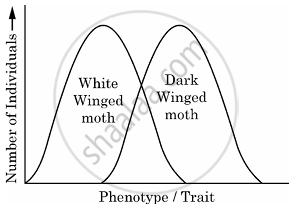Advertisements
Advertisements
Question

Natural selection operates in different ways in nature.
- Identify the type of natural selection depicted in the graph above. [1]
- In England after industrialisation, the population of dark winged moths were more favoured than white winged moth. Explain. [2]
- Anthropogenic action can enhance the rate of evolution. Explain with the help of an example. [2]
Long Answer
Solution
- Directional selection
-
- Before Industrialisation (1850s): As compared to dark-winged or melanised moths (Biston carbonaria), there were more white-winged moths (Biston betularia) on trees. This was caused by the white lichen that covered the trees, which helped the white-winged moths blend in with their surroundings and ward off predators. The dark-winged moths, on the other hand, were easier to see and feast on since they stuck out against the light background.
- After Industrialisation (1920): In contrast, fewer white-winged moths and more dark-winged moths were seen.
Pollution from industrial smoke and soot led tree trunks to darken, leading to this alteration. Pollutants reduced the growth of lichens on tree trunks.
As a result, the light-coloured lichens disappeared and the tree trunks darkened. Predators found white-winged moths more visible against the dark background, while dark-winged moths were better disguised and had a survival advantage.
The example of industrial melanism demonstrates how environmental changes caused by industry can lead to evolutionary adaptations in populations, preferring individuals with superior camouflage and survival advantages.
- Human-caused activities, known as anthropogenic actions, can accelerate evolution and significantly affect natural development. For example
- Industrial Melanism: Anthropogenic activities like industrial pollution, which emits smoke and soot, can cause changes in the environment, leading to evolutionary alterations in populations. Pollution-induced darkening of tree trunks led to the survival of dark-winged moths over white-winged moths, showing the impact of human-induced environmental changes on species evolution.
- Use of Herbicides and Pesticides: Antibiotic-resistant bacteria and resistant plant variants have been selected as a result of anthropogenic activities like the extensive use of pesticides and herbicides in agriculture. Anthropogenic activities can quicken the rate of evolutionary change in populations, frequently on short time scales, as seen by the quick development of resistance to human interventions.
shaalaa.com
Is there an error in this question or solution?
